Waveguide-Integrated Ge/Si Avalanche Photodiode with Vertical Multiplication Region for 1310 nm Detection
Abstract
1. Introduction
2. Design and Fabrication
3. Device Characterization
3.1. Static Photoresponse
3.2. Small-Signal Characteristics
4. Benchmarking and Discussion
5. Conclusions
Author Contributions
Funding
Institutional Review Board Statement
Informed Consent Statement
Data Availability Statement
Acknowledgments
Conflicts of Interest
References
- Wang, B.; Mu, J. High-speed Si-Ge avalanche photodiodes. PhotoniX 2022, 3, 8. [Google Scholar] [CrossRef]
- Wang, B.; Huang, Z.; Sorin, W.V.; Zeng, X.; Liang, D.; Fiorentino, M.; Beausoleil, R.G. A low-voltage Si-Ge avalanche photodiode for high-speed and energy efficient silicon photonic links. J. Light. Technol. 2019, 38, 3156–3163. [Google Scholar] [CrossRef]
- Wang, W.; Zhao, L.; Lu, D.; Yao, J.; Huang, W.; Liu, Y.; Little, B. Preface to the special issue on semiconductor optoelectronic integrated circuits. J. Semicond. 2021, 42, 040101. [Google Scholar] [CrossRef]
- Kumar, A.; Huang, Z.; Zeng, X.; Wang, B.; Liang, D.; Sorin, W.; Palermo, S. Design considerations for energy efficient DWDM PAM4 transceivers employing avalanche photodiodes. Laser Photonics Rev. 2020, 14, 2000142. [Google Scholar] [CrossRef]
- Hsu, Y.; Chuang, C.Y.; Wu, X.; Chen, G.H.; Hsu, C.W.; Chang, Y.C.; Tsang, H.K. 2.6 Tbit/s on-chip optical interconnect supporting mode-division-multiplexing and PAM-4 signal. IEEE Photonics Technol. Lett. 2018, 30, 1052–1055. [Google Scholar] [CrossRef]
- Xiang, Y.; Cao, H.; Liu, C.; Guo, J.; Dai, D. High-speed waveguide Ge/Si avalanche photodiode with a gain-bandwidth product of 615 GHz. Optica 2022, 9, 762–769. [Google Scholar] [CrossRef]
- Sun, C.; Wade, M.T.; Lee, Y.; Orcutt, J.S.; Alloatti, L.; Georgas, M.S.; Stojanović, V.M. Single-chip microprocessor that communicates directly using light. Nature 2015, 528, 534–538. [Google Scholar] [CrossRef]
- Li, Y.; Liu, X.; Li, X.; Zhang, L.; Li, Y.; Chen, B.; Song, J. Lateral separate absorption charge multiplication Ge-on-Si avalanche photodiode with low dark current in linear mode. Opt. Commun. 2022, 518, 128343. [Google Scholar] [CrossRef]
- Liu, D.; Zhang, P.; Tang, B.; Wang, W.; Li, Z. High-Performance Waveguide-Integrated Ge/Si Avalanche Photodetector with Lateral Multiplication Region. Micromachines 2022, 13, 649. [Google Scholar] [CrossRef]
- Benedikovic, D.; Virot, L.; Aubin, G.; Hartmann, J.M.; Amar, F.; Le Roux, X.; Vivien, L. 40 Gbps heterostructure germanium avalanche photo receiver on a silicon chip. Optica 2020, 7, 775–783. [Google Scholar] [CrossRef]
- Virot, L.; Crozat, P.; Fédéli, J.M.; Hartmann, J.M.; Marris-Morini, D.; Cassan, E.; Vivien, L. Germanium avalanche receiver for low power interconnects. Nat. Commun. 2014, 5, 4957. [Google Scholar] [CrossRef] [PubMed]
- Chen, H.T.; Verbist, J.; Verheyen, P.; De Heyn, P.; Lepage, G.; De Coster, J.; Roelkens, G. 25-Gb/s 1310-nm optical receiver based on a sub-5-V waveguide-coupled germanium avalanche photodiode. IEEE Photonics J. 2015, 7, 15357076. [Google Scholar] [CrossRef]
- Assefa, S.; Xia, F.; Vlasov, Y.A. Reinventing germanium avalanche photodetector for nanophotonic on-chip optical interconnects. Nature 2010, 464, 80–84. [Google Scholar] [CrossRef] [PubMed]
- Decker, D.R.; Dunn, C.N. Determination of germanium ionization coefficients from small-signal IMPATT diode characteristics. IEEE Trans. Electron Devices 1970, 17, 290–299. [Google Scholar] [CrossRef]
- Chen, H.T.; Verheyen, P.; De Heyn, P.; Lepage, G.; De Coster, J.; Absil, P.; Van Campenhout, J. High-responsivity low-voltage 28-Gb/s Ge pin photodetector with silicon contacts. J. Light. Technol. 2015, 33, 820–824. [Google Scholar] [CrossRef]
- Srinivasan, S.A.; Lambrecht, J.; Guermandi, D.; Lardenois, S.; Berciano, M.; Absil, P.; Van Campenhout, J. 56 Gb/s NRZ O-band hybrid BiCMOS-silicon photonics receiver using Ge/Si avalanche photodiode. J. Light. Technol. 2020, 39, 1409–1415. [Google Scholar] [CrossRef]
- Srinivasan, S.A.; Lambrecht, J.; Berciano, M.; Lardenois, S.; Absil, P.; Bauwelinck, J.; Van Campenhout, J. Highly sensitive 56 Gbps NRZ O-band BiCMOS-silicon photonics receiver using a Ge/Si avalanche photodiode. In Proceedings of the 2020 Optical Fiber Communications Conference and Exhibition (OFC), San Diego, CA, USA, 8–12 March 2020. [Google Scholar]
- Srinivasan, S.A.; Berciano, M.; De Heyn, P.; Lardenois, S.; Pantouvaki, M.; Van Campenhout, J. 27 GHz silicon-contacted waveguide-coupled Ge/Si avalanche photodiode. J. Light. Technol. 2020, 38, 3044–3050. [Google Scholar] [CrossRef]
- Ono, H.; Fujikata, J.; Noguchi, M.; Takahashi, H.; Shimura, D.; Yaegashi, H.; Sasaki, H. Si photonics butt-coupled waveguide germanium avalanche photodiodes with lateral SAM structures. In Proceedings of the Optical Fiber Communication Conference, Optical Society of America, San Diego, CA, USA, 3–7 March 2019; Volume 1–3. [Google Scholar]
- Srinivasan, S.A.; De Heyn, P.; Hiblot, G.; Chen, H.; Lardenois, S.; Pantouvaki, M.; Van Campenhout, J. Silicon-contacted waveguide integrated Ge/Si avalanche photodiode with 32 GHz bandwidth and multiplication gain > 8. In Proceedings of the 45th European Conference on Optical Communication (ECOC 2019), Dublin, Ireland, 22–26 September 2019; pp. 1–3. [Google Scholar]
- Zeng, X.; Huang, Z.; Wang, B.; Liang, D.; Fiorentino, M.; Beausoleil, R.G. Silicon–germanium avalanche photodiodes with direct control of electric field in charge multiplication region. Optica 2019, 6, 772–777. [Google Scholar] [CrossRef]
- Li, Z.; Liu, X.; Zuo, C.; Yang, W.; Fang, X. Supersaturation-Controlled Growth of Monolithically Integrated Lead-Free Halide Perovskite Single-Crystalline Thin Film for High-Sensitivity Photodetectors. Adv. Mater. 2021, 33, 2103010. [Google Scholar] [CrossRef]
- Kang, Y.; Liu, H.D.; Morse, M.; Paniccia, M.J.; Zadka, M.; Litski, S.; Campbell, J.C. Monolithic germanium/silicon avalanche photodiodes with 340 GHz gain–bandwidth product. Nat. Photonics 2009, 3, 59–63. [Google Scholar] [CrossRef]
- Wang, B.Z.; Huang, X.; Zeng, D.; Liang, M.; Fiorentino, W.V.; Sorin, W.V.; Beausoleil, R.G. 50 Gb/s PAM4 low-voltage Si-Ge avalanche photodiode. In Proceedings of the Conference on Lasers and ElectroOptics (CLEO), San Jose, CA, USA, 7–12 May 2019. [Google Scholar]
- Chrostowski, L.; Hochberg, M. Silicon Photonics Design: From Devices to Systems; Cambridge University Press: Cambridge, UK, 2015; pp. 98–103. [Google Scholar]
- Knights, A.P.; Reed, G.T.; Ribaud, K.; Lemonnier, O.; Lyan, P.; Hartmann, J.-M.; Petit-Etienne, C.; Sciancalepore, C.; Pargon, E.; Bellegarde, C. Optimization of H2 thermal annealing process for the fabrication of ultra-low loss sub-micron silicon-on-insulator rib waveguides. In Proceedings of the Silicon Photonics XIII, San Francisco, CA, USA, 27 January–1 February 2018. [Google Scholar]
- Reed, G.T.; Knights, A.P.; Bellegarde, C.; Pargon, E.; Sciancalepore, C.; Petit-Etienne, C.; Hughes, V.; Hartmann, J.-M.; Lyan, P. Improvement of sidewall roughness of sub-micron silicon-on-insulator waveguides for low-loss on-chip links. In Proceedings of the Silicon Photonics XII, San Francisco, CA, USA, 27 January–1 February 2018. [Google Scholar]
- Samani, A.; Carpentier, O.; El-Fiky, E.; Jacques, M.; Kumar, A.; Wang, Y.; Plant, D.V. Highly sensitive, 112 Gb/s O-band waveguide coupled silicon-germanium avalanche photodetectors. In Proceedings of the 2019 Optical Fiber Communications Conference and Exhibition (OFC), San Diego, CA, USA, 3–7 March 2019; pp. 1–3. [Google Scholar]
- Carpentier, O.; Samani, A.; Jacques, M.; El-Fiky, E.; Alam, M.S.; Wang, Y.; Plant, D. High gain-bandwidth waveguide coupled silicon germanium avalanche photodiode. In Proceedings of the Conference on Lasers and Electro-Optics, OSA Technical Digest, Washington, DC, USA, 10–15 May 2020; p. STh4O-3. [Google Scholar]
- Zhu, Y.; Yang, Q.; Wang, Q. Effect of Si-Ge interdiffusion on the waveguide properties of SiGe-Si MQW photodetector. IEEE J. Quantum Electron. 1997, 33, 761–764. [Google Scholar]
- Luong, T.K.P.; Dau, M.T.; Zrir, M.A.; Stoffel, M.; Le Thanh, V.; Petit, M.; Murota, J. Control of tensile strain and interdiffusion in Ge/Si(001) epilayers grown by molecular-beam epitaxy. J. Appl. Phys. 2013, 114, 083504. [Google Scholar] [CrossRef]
- Emmons, R.B. Avalanche-photodiode frequency response. J. Appl. Phys. 1967, 38, 3705–3714. [Google Scholar] [CrossRef]
- Piels, M.; Ramaswamy, A.; Zaoui, W.S.; Bowers, J.E.; Kang, Y.; Morse, M. Microwave Nonlinearities in Ge/Si Avalanche Photodiodes having a Gain-Bandwidth Product of 300 GHz. In Proceedings of the Optical Fiber Communication Conference and National Fiber Optic Engineers Conference, OSA Technical Digest (CD) (Optical Society of America, 2009), OMR1, San Diego, CA, USA, 22–26 March 2009. [Google Scholar]
- Wang, B.; Huang, Z.; Zeng, X.; Sorin, W.V.; Liang, D.; Fiorentino, M.; Beausoleil, R.G. A Compact Model for Si-Ge Avalanche Photodiodes Over a Wide Range of Multiplication Gain. J. Light. Technol. 2019, 37, 3229–3235. [Google Scholar] [CrossRef]
- Yoon, J.; Lee, S.-M.; Kang, D.; Meitl, M.A.; Bower, C.A.; Rogers, J.A. Heterogeneously Integrated Optoelectronic Devices Enabled by Micro-Transfer Printing. Adv. Opt. Mater. 2015, 3, 1313–1335. [Google Scholar] [CrossRef]
- Kum, H.; Lee, D.; Kong, W.; Kim, H.; Park, Y.; Kim, Y.; Baek, Y.; Bae, S.; Lee, K.; Kim, J. Epitaxial growth and layer-transfer techniques for heterogeneous integration of materials for electronic and photonic devices. Nat. Electron. 2019, 2, 439–450. [Google Scholar] [CrossRef]
- Meng, Y.; Feng, J.G.; Han, S.M.; Xu, Z.H.; Mao, W.B.; Zhang, T.; Kim, J.S.; Roh, I.; Zhao, Y.P.; Kim, D.H.; et al. Photonic van der Waals integration from 2D materials to 3D nanomembranes. Nat. Rev. Mater. 2023, 1–20. [Google Scholar] [CrossRef]
- Schlipf, J.; Berkmann, F.; Yamamoto, Y.; Reichenbach, M.; Veleski, M.; Kawaguchi, Y.; Mörz, F.; Tomm, J.W.; Weißhaupt, D.; Fischer, I.A. Robust Si/Ge heterostructure metasurfaces as building blocks for wavelength-selective photodetectors. Appl. Phys. Lett. 2023, 122, 121701-1–121701-7. [Google Scholar] [CrossRef]
- Meng, Y.; Chen, Y.; Lu, L.; Ding, Y.; Cusano, A.; Fan, J.A.; Hu, Q.; Wang, K.; Xie, Z.; Liu, Z.; et al. Optical meta-waveguides for integrated photonics and beyond. Light. Sci. Appl. 2021, 10, 235. [Google Scholar] [CrossRef] [PubMed]
- Jiang, Z.; Yu, Y.; Wang, Y.; Zhou, D.; Deng, W.; Zhang, X. Waveguide Si-Ge avalanche photodiode based on hole-generated impact ionization. In Proceedings of the 2019 Optical Fiber Communications Conference and Exhibition (OFC), San Diego, CA, USA, 3–7 March 2019; pp. 1–3. [Google Scholar]
- Huang, M.; Cai, P.; Li, S.; Hou, G.; Zhang, N.; Su, T.I.; Pan, D. 56GHz waveguide Ge/Si avalanche photodiode. In Proceedings of the 2018 Optical Fiber Communications Conference and Exposition (OFC), San Diego, CA, USA, 11–15 March 2018; pp. 1–3. [Google Scholar]
- Martinez, N.J.; Derose, C.T.; Brock, R.W.; Starbuck, A.L.; Pomerene, A.T.; Lentine, A.L.; Davids, P.S. High performance waveguide-coupled Ge-on-Si linear mode avalanche photodiodes. Opt. Express 2016, 24, 19072–19081. [Google Scholar] [CrossRef] [PubMed]
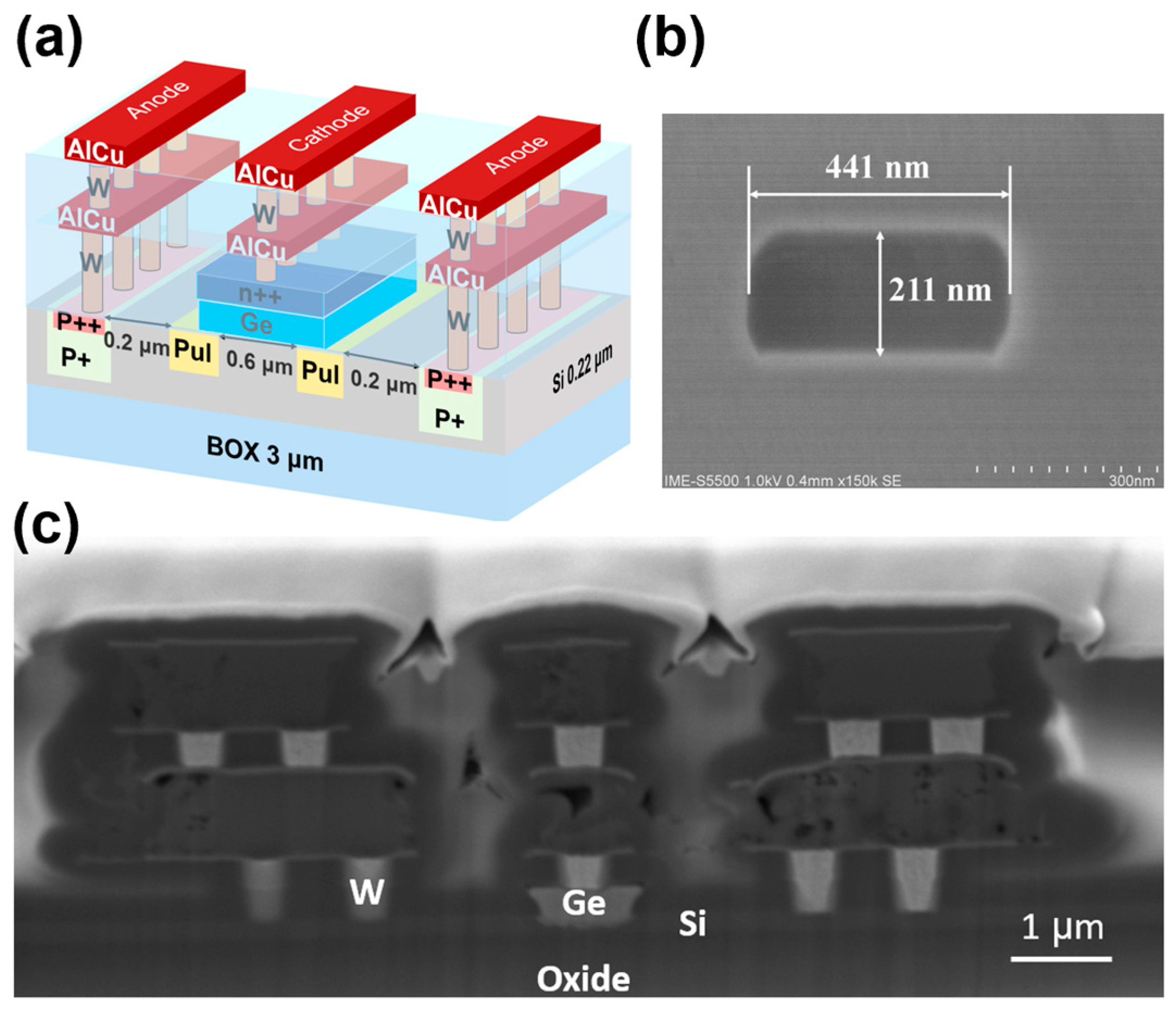
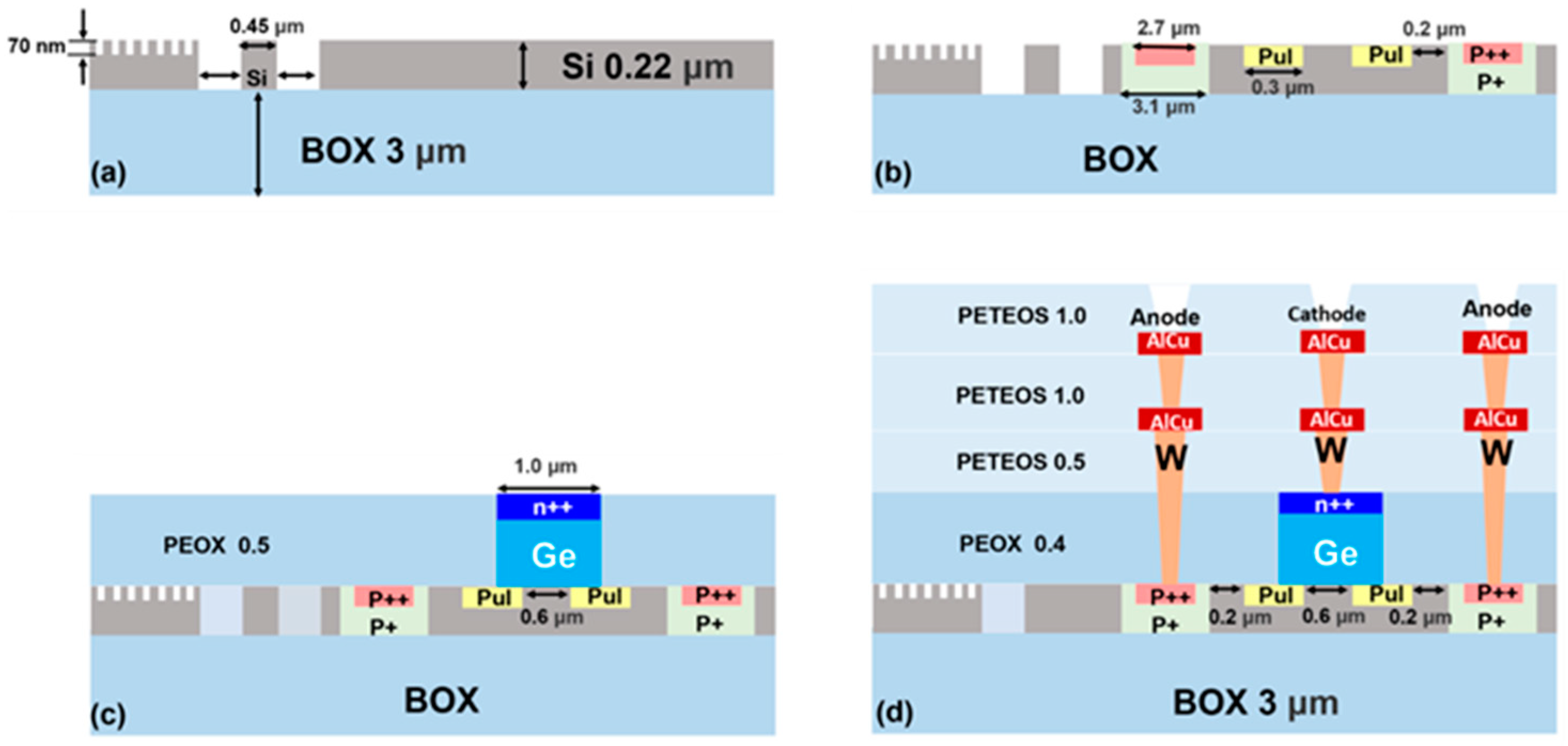
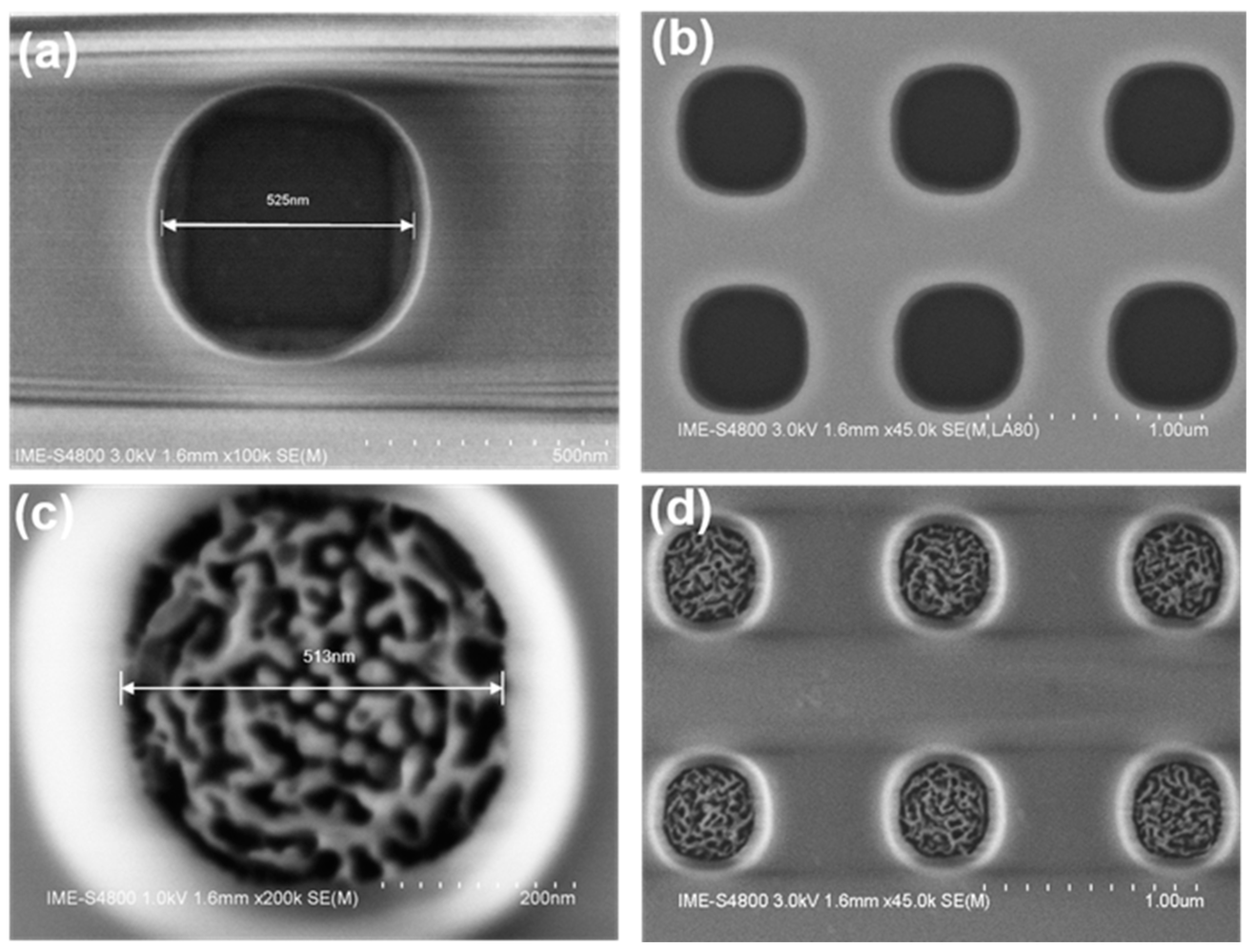

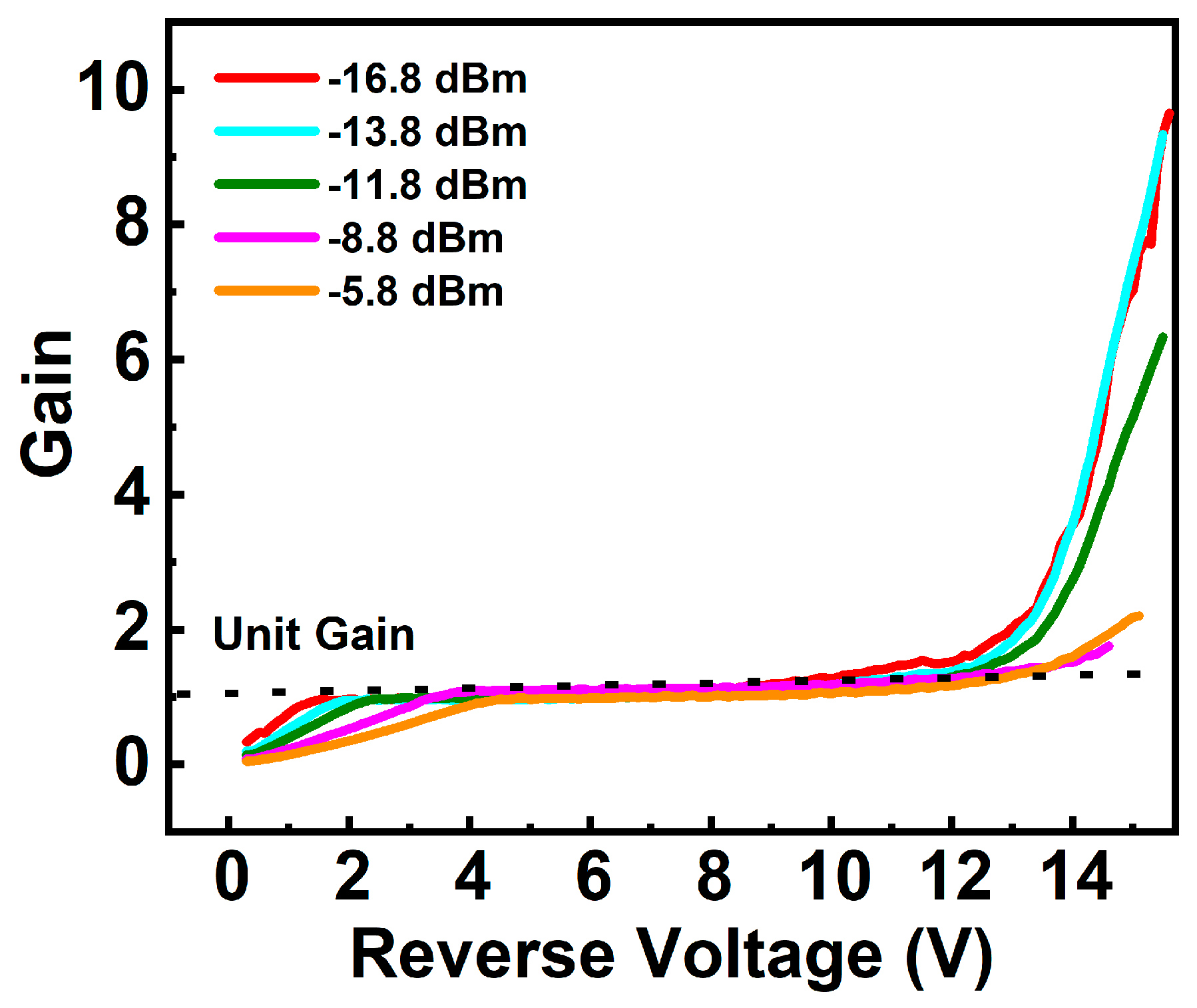

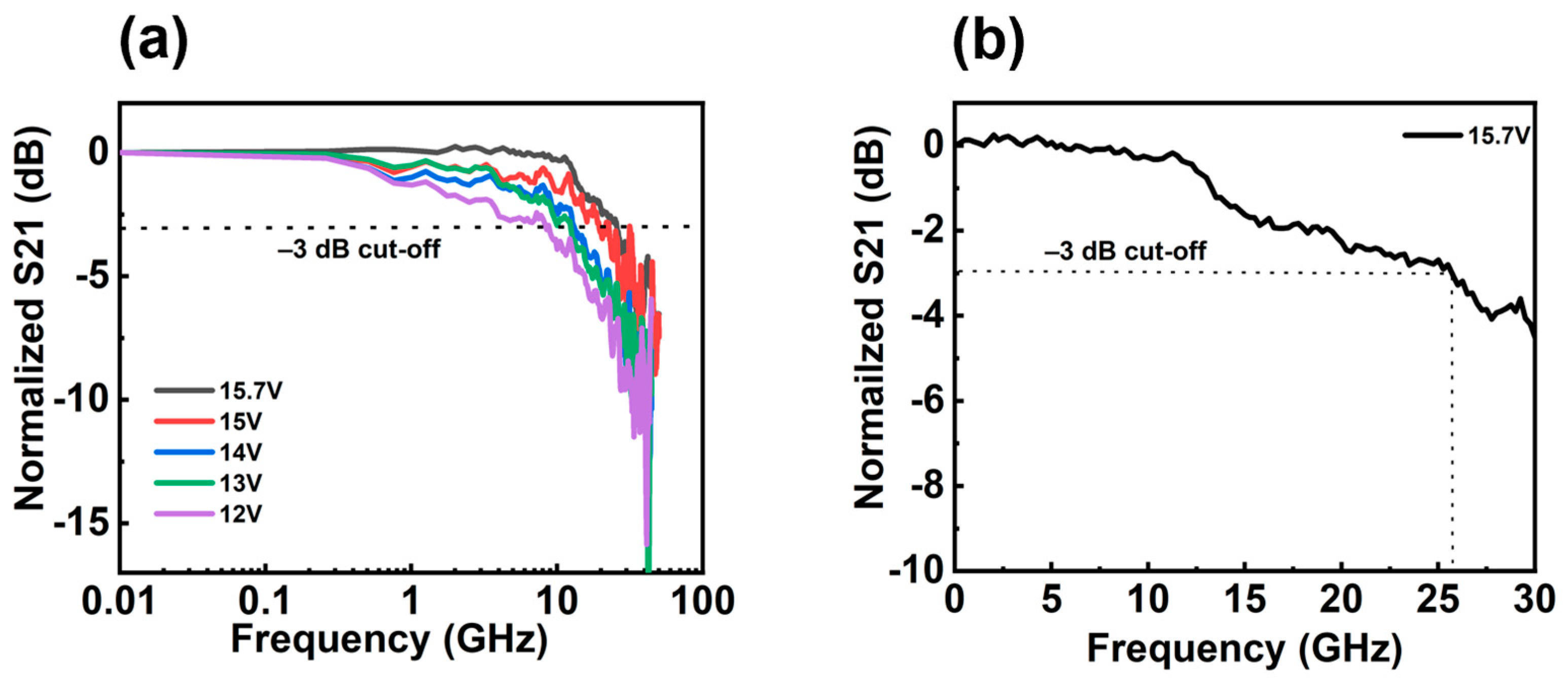
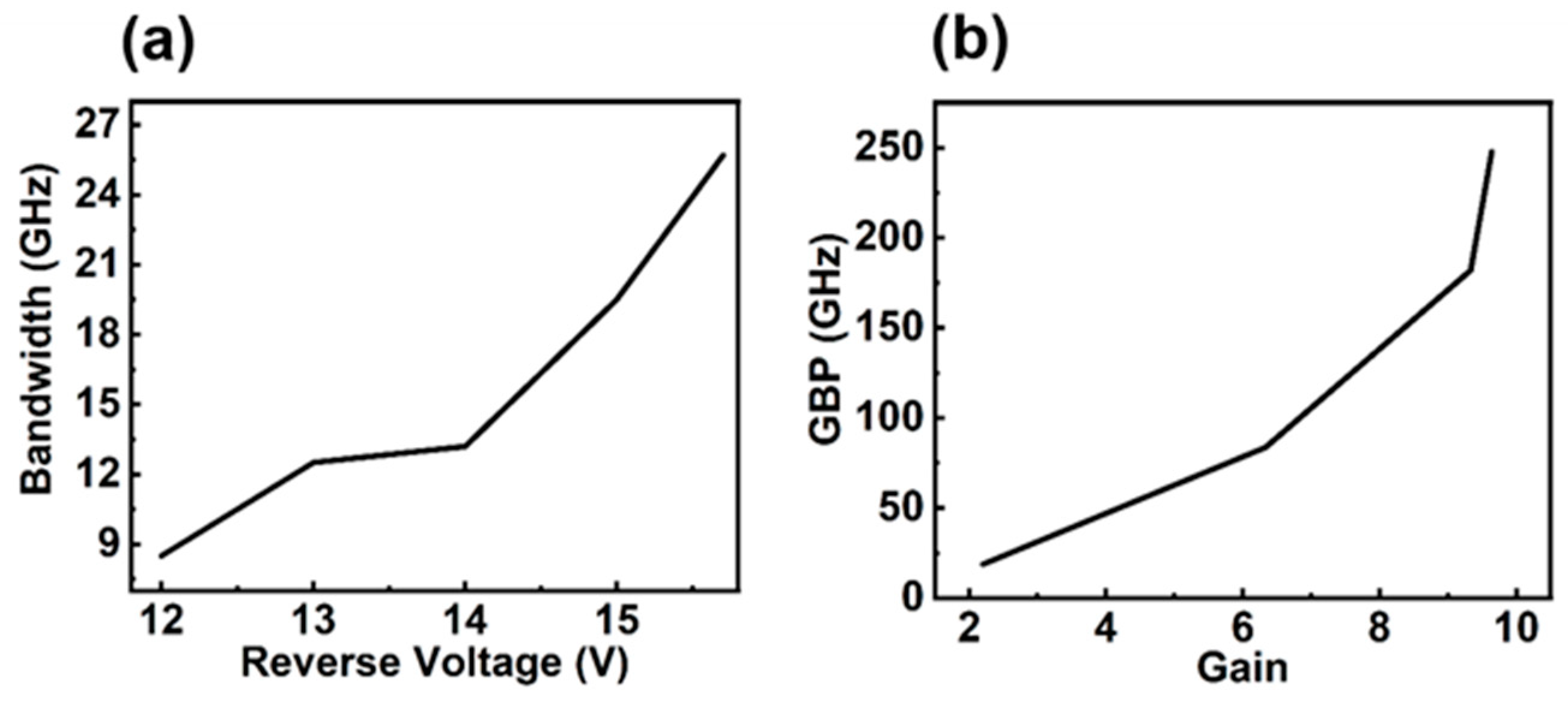
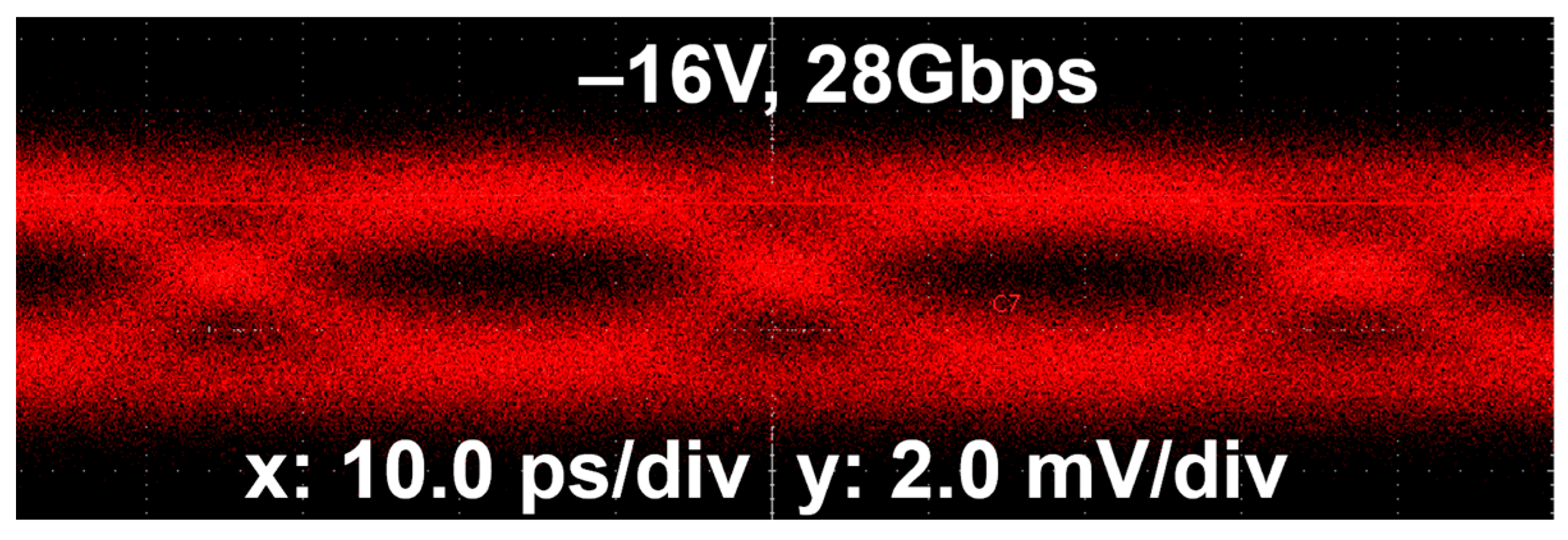
| Ref. | Device Type | λ (nm) | Vbias (V) | Idark (µA) | R0 (A/W) | 3 dB BW (GHz) | GBP (GHz) |
|---|---|---|---|---|---|---|---|
| [6] | Lateral RT | 1310 | 14 | 100 | 0.93 | 48 | 615 |
| [9] | Lateral SAM | 1550 | 10.6 | 31.9 | 0.8 | 20.7 | 217 |
| [10] | Lateral p(Ge)-i(Ge)-n(Si) | 1550 | 11 | 600 | 0.49 | 33 | 210 |
| [11] | Lateral p-i-n-Ge | 1550 | 7 | 610 | 0.4 | 11 | 190 |
| [16] | Lateral SACM | 1310 | 10 | 30 | 0.65 | 22.7 | 238 |
| [21] | Vertical SACM-p(Ge) | 1550 | 6.4 | 1000 | 0.48 | 18.9 | 284 |
| [40] | Vertical SACM-n(Ge) | 1550 | 8.5 | 37 | 0.8 | 18.2 | 182 |
| [41] | Vertical SACM-p(Ge) | 1310 | 18 | 0.27 | 0.6 | 36 | 360 |
| [42] | Vertical SACM-p(Ge) | 1550 | 31 | 100 | 0.8 | 6.24 | 432 |
| This work | Vertical SACM-n(Ge) | 1310 | 15.7 | 450 | 0.68 | 25.7 | 247 |
Disclaimer/Publisher’s Note: The statements, opinions and data contained in all publications are solely those of the individual author(s) and contributor(s) and not of MDPI and/or the editor(s). MDPI and/or the editor(s) disclaim responsibility for any injury to people or property resulting from any ideas, methods, instructions or products referred to in the content. |
© 2023 by the authors. Licensee MDPI, Basel, Switzerland. This article is an open access article distributed under the terms and conditions of the Creative Commons Attribution (CC BY) license (https://creativecommons.org/licenses/by/4.0/).
Share and Cite
Yi, L.; Liu, D.; Li, D.; Zhang, P.; Tang, B.; Li, B.; Wang, W.; Yang, Y.; Li, Z. Waveguide-Integrated Ge/Si Avalanche Photodiode with Vertical Multiplication Region for 1310 nm Detection. Photonics 2023, 10, 750. https://doi.org/10.3390/photonics10070750
Yi L, Liu D, Li D, Zhang P, Tang B, Li B, Wang W, Yang Y, Li Z. Waveguide-Integrated Ge/Si Avalanche Photodiode with Vertical Multiplication Region for 1310 nm Detection. Photonics. 2023; 10(7):750. https://doi.org/10.3390/photonics10070750
Chicago/Turabian StyleYi, Linkai, Daoqun Liu, Daimo Li, Peng Zhang, Bo Tang, Bin Li, Wenwu Wang, Yan Yang, and Zhihua Li. 2023. "Waveguide-Integrated Ge/Si Avalanche Photodiode with Vertical Multiplication Region for 1310 nm Detection" Photonics 10, no. 7: 750. https://doi.org/10.3390/photonics10070750
APA StyleYi, L., Liu, D., Li, D., Zhang, P., Tang, B., Li, B., Wang, W., Yang, Y., & Li, Z. (2023). Waveguide-Integrated Ge/Si Avalanche Photodiode with Vertical Multiplication Region for 1310 nm Detection. Photonics, 10(7), 750. https://doi.org/10.3390/photonics10070750





